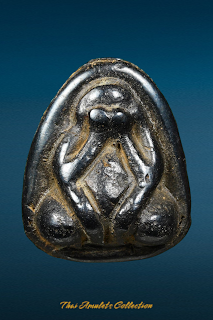Phra Pidta Lang Yant – “Nun Mekhaphat” (Cloud Spell Back Yantra) BE2450–2460
Created by: Luang Pu Thong (Luang Pho Thong)
Temple: Wat Ratchayotha (Wat Rachayotha), Bangkok
1. Background of Wat Ratchayotha
Wat Ratchayotha, located in Bangkok, is an ancient temple known for its strong connections to the royal family and for being a center of learning and spiritual practice. Over the years, it has been home to many revered monks, including Luang Pu Thong, who served as a pivotal spiritual figure during the late 19th to early 20th centuries.
2. Biography of Luang Pu Thong (Luang Pho Thong)
-
Era of Activity: Approximately late King Rama V to early Rama VI reign.
-
Estimated Birth: Around mid-1800s.
-
Death: Unknown, but he was most active during the creation of this amulet batch (circa BE2450–2460).
-
Renowned for his deep practice in Wicha (occult sciences), Vipassana meditation, and protective magic (Katha-Akom).
-
A highly respected monk in the central region, Luang Pu Thong mentored many monks and was known for consecrating sacred objects that were effective in protection and invulnerability.
3. Features of Phra Pidta Lang Yant – Nun Mekhaphat
-
Front Image: Classic Phra Pidta posture – Buddha covering the eyes, symbolizing withdrawal from worldly defilements and achieving deep inner peace.
-
Back Inscription (Lang Yant): The rare Yant Nun Mekhaphat, a powerful yantra believed to disperse clouds of bad karma, enhance luck, and serve as invisible protection. “Mekhaphat” translates to “cloud shield” or “storm disperser,” metaphorically protecting the wearer from dangers.
-
Material (Nur): Sacred powder (Phong Phra) mixed with herbs, incense ash, pollen, and other esoteric substances blessed through repeated chanting.
-
Amulet Form: Compact and rounded, often handmade or pressed from a wooden or bronze mold. The back typically shows the delicate hand-drawn yantra (cloud pattern).
4. Purpose of Creation
Luang Pu Thong created this batch of amulets to:
-
Protect laypeople and monks during times of civil unrest and spiritual uncertainty in the early 20th century.
-
Provide spiritual shielding against harm, bad luck, and supernatural influences.
-
Promote peace of mind, meditative clarity, and baramee (accumulated spiritual merit).
5. Consecration Ceremony
-
Timeframe: Circa BE2450–2460 (1907–1917).
-
The consecration was likely held within the sacred halls of Wat Ratchayotha, with Luang Pu Thong performing intensive meditation and chanting (plook sek) over an extended period.
-
Oral traditions indicate participation of other revered monks from Bangkok and nearby provinces, creating a highly charged spiritual atmosphere.
6. Spiritual Significance and Beliefs
-
Invulnerability (Kongkraphan): Protection against weapons and physical harm.
-
Metta Maha Niyom: Generates loving-kindness and popularity.
-
Klaew Klaad: Helps avoid danger and misfortune.
-
Protection from Black Magic: The yantra dispels spiritual attacks and harmful intent.
-
Inner Peace and Wisdom: Encourages meditation and clarity.
7. Rarity and Value
-
Due to the limited number produced, surviving pieces today are extremely rare and considered sacred heirlooms.
-
Many are kept in families as protective talismans or are passed down through generations.
-
Highly respected among serious collectors and spiritual devotees, especially in central Thailand.

%20Wat%20Rachayota%20with%20Thaprachan%20Certificate.png)




